LESSON 8: THE RELATION OF MAGIC TO OTHER SCIENCES
Magic is made light of and dismissed as foolishness by some people, but it is fortunate that there are few of these people. If these people were well informed, they would hold no such opinion of Magic. Those who are learned know that Magic was really the fount of almost all knowledge. With the tremendous significance attached to it in the annals of history, Magic cannot be dismissed with a shrug. It must be credited with more than just the distinction of being entertaining. One's researches must go deep to understand the Mystic Art thoroughly. We must realize that although Magic is now an entertaining art, it was the root from which sprang some of our great sciences.
I have traced for you the History of Magic in its various phases, Magic's Relation to Religion and to the Art of Medicine. In this lesson I will complete my outline of the background of the Mystic Art by discussing for you Magic's Relation to the Sciences of Astronomy, Chemistry, Pharmacy and Physics.
Astrology -- Foundation for Astronomy
Astrology is the pseudo-science of the stars and planets, which was the foundation for our modern science of Astronomy. When the peoples of antiquity conceived of the idea that God has made these planets as His perfect works and set them on high in the heavens, the Astrological system began. Starting with worship of the celestial bodies and the attributing to them of magical powers, the next step in Astrology was to classify the whole world into divisions which were supposedly under the influence of certain planets.
Different parts of the human body, different animals, plants, metals, and different countries were designated as under the influence of certain planets. This developed into a very complicated planetary system built up on magical beliefs. In Lesson 6 I told about the belief in the magic influence of the planets in the Art of Medicine. The Astrological system covers far more than the Medical Art, however; within the scope of its magical influences lie many, many factors in human life.
To make this clear to you, I will take the Planet Mars and give you an outline of its widespread Astrological influence:
Magic Influence of Mars
Mars is a masculine, nocturnal, hot and dry planet of the fiery division, the author of strife. One born under Mars is short, strongly made, has large bones, ruddy complexion, red or sandy hair, quick, sharp eyes, and round, bold face. If a strong character, this person will be courageous, unafraid, careless of life. If weak in character, this person will be a trumpeter of his own fame, fond of quarrels and fighting and given to oppression. Nero of Rome was of this type.
This planet was believed to rule the head, face, left ear, and the sense of smell. Diseases: plague, fevers, wounds from iron or steel, injuries by poison, and evil effects from anger. Herbs and plants: mustard, radish, all pungent and thorny plants. Gems: bloodstone, ruby, and garnet. Minerals: iron, arsenic, sulphur. Animals: mastiff, wolf, tiger, and all savage beasts. Birds hawk, vulture, and all birds of prey. Weather: thunder and lightning, and all strange phenomena. Kingdoms: Lombardy and Bavaria. Cities: Jerusalem and Rome. It is the ruling planet for soldiers, surgeons, barbers, and butchers. Places: slaughter-houses, battlefields, brick kilns, blacksmiths' shops. Friends: all the planets except the Moon and Jupiter. Color is red and Angel is Samael.
You can easily see how this system developed. Mars was a planet of strength and power. The god, Mars, was designated as the god of War. Naturally those minerals, plants, those weather conditions and those professions which indicated power and forcefulness and strength were put under the influence of this planet. The old magical beliefs in the elements, in the plants, etc., had merely been arranged and systematized into the pseudo-science of Astrology.
Modern Development
From this system grew our modern scientific Astronomy, which has released the science of the planets from magical beliefs. Astrology, however, still exists and is believed in by many people. It is especially known today as the Horoscope, which predicts from the time of a person's birth what his future will be because of the influence of the particular planet under which he was born.
Alchemy — Foundation for Chemistry
Astrology with its magical origin was the foundation of another pseudo-science, Alchemy. The division of the metals among the planets led to the belief that the metals were formed by the influence of a certain planet for each -- thus the same matter under the rays of Saturn became lead, under those of Jupiter, tin, and under those of Venus, copper, under certain influence of the Moon it became silver, and by power of the sun it became gold.
Alchemy dealt primarily with the discovery of the properties of matter — how certain matter came into being and what it was composed of. It was, however, bound up with Magic. It was believed that the spirits in the planets controlled these metals and the Alchemist was believed to have supernatural and mysterious powers.
The purposes of Alchemy were:
1 - Discovery of the philosopher's stone, which would create and multiply gold.
2 - Making of an alkahest or universal solvent.
3 - Composition of an infallible, universal remedy, called the elixir of life.
The philosopher's stone, it was believed, if found, would reduce all matter to its perfect form. It applied to plants, animals, earth and stone, and even to spirits. It would transform the basest metals into silver and gold, and flint into precious rubies and diamonds. It would make all the world — even the remote parts and secret hidden caves -- visible to the holder of the stone.
The universal solvent was believed to be capable of dissolving all metals, even gold, and thus if it were found it would aid the Alchemist in discovering what the metals were formed of and would enable him to transmute or change them into purer form. This universal solvent was later exposed as ridiculous, for if this solvent were universal, what vessel would hold it?
The elixir of life was supposed to be a red medicine which would give long life and perfect health to the user. There were two problems attached to this mystery, however. Not only must the elixir be discovered, but the method of using it must also be found. It was believed to be so powerful that if used wrong, it would dissolve the whole body. A number of vague writings have been left us on this subject. Some of the philosophers believed that they had found this elixir and left prescriptions for making it. These formulae, however, are so vague and depend so much on magic that we poor mortals must go on unknowing.
These pseudo-sciences which I have discussed began with Magic and were, so closely bound up with it for centuries that all the secrecy and mysteriousness of Magic clung to the pseudo-sciences. Later when the real Sciences of Chemistry, of Astronomy developed, they were freed from magical beliefs and were given openly to the public. Though the secrecy was done away with, some of the atmosphere of the supernatural still clung to these sciences in the minds of people.
Science of Pharmacy
Pharmacy was, of course, an outgrowth of Chemistry and Medicine. First, it was allied with Medicine and Astrology and Magic. Then with the development of Alchemy and finally of Chemistry, it was placed on a scientific basis.
Science of Physics
The Science of Physics — that which deals with mechanics, light, heat, and sound; in short, that which deals with the physical influences in the world — cannot be definitely traced back to Magic for its origin. However, we can believe that as Magic opened the way to an understanding of nature and caused men to search for knowledge. and thus was the tree from which sprang the other branches of the Sciences, so the searching, at least, for other Sciences — Physics, Optics, and others — had its origin with Magic. We do know that Roger Bacon, as I brought to your attention in the first lesson, studied the sciences and did much to develop the Science of Optics. Yet Roger Bacon was regarded as a Magician, and Optics, though since known to be a science not dependent on Magic, was then regarded as part of the Mystic Art.
It is astounding when we stop to consider the development of our great sciences and the understanding of the world which they bring to us, and then realize that all this had its origin in Magic — Magic which was to human beings the most tremendous influence in life and which to us now is the most entertaining of all arts.
MAGIC IS EDUCATIONAL
The great sciences for which Magic was the foundation are now the foundation for Magic. The whole Art is closely allied with these sciences, and delving into the mysteries of Magic leads you into some study of the sciences. Magic uses physics, mechanics, optics, electricity, chemistry, psychology in getting its effects. As you learn Magic, you learn something about these sciences. The people of ancient times developed the foundation for them through their belief in Magic, and now you, working from the opposite angle, will reach out into the sciences to gain your understanding of Magic.
The knowledge you get through your study of Magic will, of course, add much to your store of learning and will help you very much in your business, in your social life, or in the Profession of Magic.
The tricks in Magic depend on the sciences. Most tricks depend on optics and the physical science of light, heat, sound; others depend on mechanics; some on electricity; and all depend on psychology for their effect. You have, no doubt, some understanding of this already from the few lessons which you have studied. You will realize this more and more as you proceed with your studies.
Increases Thinking Powers
Aside from this educational material which Magic gives you, it does something else for you. It broadens your mind and increases your thinking powers to an extent which you will find invaluable in every walk of life. It is only natural, of course, that Magic should do this. You know already that it requires concentration and real thinking to learn it. This is wonderful training for your mind. And then when you are performing, it requires quick thinking and thinking of a number of things at once.
Mastering Magic gives you the additional rewards of making you alert and wide-awake and keen of mind -- qualities which you must have to be a real Magician. You know from your studies I am sure, how Magic does this. You have found the tricks very simple in method, yet you have realized too that in spite of their simplicity, you cannot do them well until you have mastered the principles and the moves and the fundamentals and can present them in a finished manner.
You know that to be able to do this you must be alert and must think quickly and clearly. You gain this ability from Magic itself — for what Magic requires of you, it gives to you. By this I mean -- Magic requires accurate knowledge and snappy thinking on your part, and it teaches you to fulfill these requirements.
LESSON 8
In this lesson we work on mathematical principles and effects. You will find the principles useful in performing other effects. And the experiments themselves, are well suited to parlor, club, or stage performance.
1. MYSTERY OF THE TRAVELING NUMBERS
EFFECT:
Performer shows a piece of red tissue paper on both sides and holds it to the light to prove that it is unprepared. He rolls this into a ball and gives it to a spectator to hold. Performer now takes a small white card and shows it on both sides. Then he asks a spectator to write a number of three digits, such as 342 or 569, on the card. Then in rotation, four more spectators are asked to write such numbers on the card under each other. A sixth member of the audience is requested to add the five numbers and write the sum. Magician calls attention to the fact that the tissue paper was unprepared and that the numbers were written from free choice and the sum was not known to him beforehand. In spite of all this, he causes the numbers of the sum to become imprinted on the tissue paper. The spectator who has been holding ball of tissue paper is asked to unroll it, and the numbers of the sum are found written there in black ink.
PARAPHERNALIA:
1--A sheet of red tissue paper, twelve inches square.
2--Another sheet of red tissue paper the same size with the numbers 2573 printed plainly on it in black ink. See Figure 1.
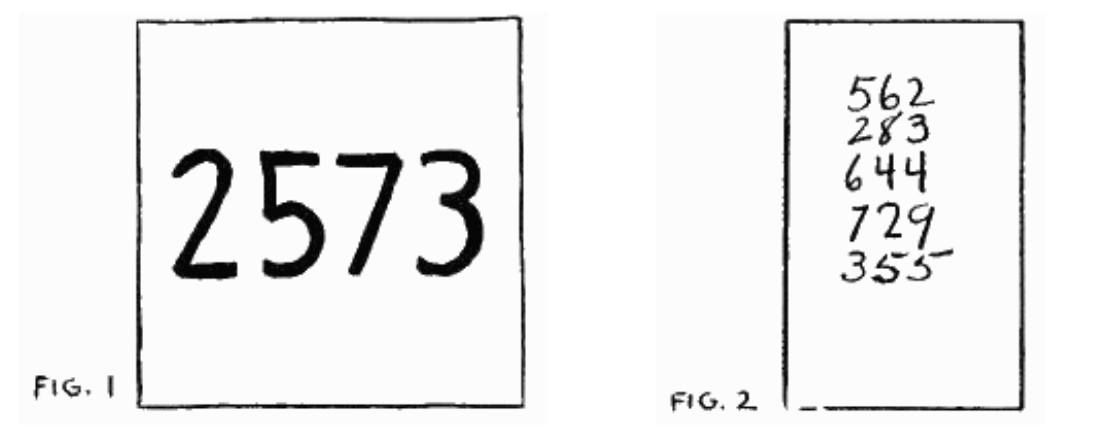
3--A small white card about 2 x 3 1/2 inches. On one side write the following numbers in pencil as illustrated in Figure 2. Try to make each number look as though it had been written by a different person. 4--A book, to be used as a support for writing on card.
5--A lead pencil.
SECRET AND PATTER:
To Prepare:
Roll tissue paper with 2573 on it into a small ball and place in right coat pocket.
Place plain sheet of tissue folded up rather small in same pocket.
Put the small card with numbers written on it also in same pocket.
Have book handy on a table near you.
To Perform:
Put hand into right coat pocket. Take blank sheet of tissue paper and finger palm the other sheet which is rolled into a ball. In your lesson on the torn and restored paper napkin you learned how to finger palm a ball of paper.
"In performing my next experiment I am going to make use of a plain piece of tissue paper. I want you to notice that it is plain on both sides. I hold it here in front of this light so that you can see through it too. Just a piece of tissue paper such as you would use to wrap Christmas packages."
Show both sides of paper. If there is a light near, hold paper in front of it. If this is not convenient, just show paper freely. The back of the right hand is toward the audience to conceal ball of paper. Use left hand freely in showing paper.
"For the time being, I will roll it into a small ball."
Roll paper into small ball. Now work as you did in the torn and restored napkin trick. Manipulate the palmed ball of paper up into fingers and hold the two balls as one.
"It would take a good acrobat or contortionist to roll himself up any smaller, wouldn't it?"
Palm away the plain ball with right hand. Let right hand drop to side. Prepared ball is held in left hand on level with your chest.
"Now to place the little ball of paper in good company, Madam, I am going to ask you to be so kind as to take care of this little one for a few moments." Give prepared ball to a lady to hold.
"Keep it in sight all the time so that the audience can see it."
Reach into right coat pocket for the white card and leave the palmed ball of plain paper in pocket. Take card out with blank side toward audience. They must never know about numbers written on the back of card. "We will use this plain white card next. Same color on both sides."
NOW COMES AN IMPORTANT MOVE.
You apparently show both sides of the card to the audience but in reality show only one. You must practice this in front of your mirror until you are able to perform the move smoothly and quickly. The illusion is perfect when the move is performed properly.
Hold card as in illustration 3. Blank side of card is toward audience. Back of hand is toward you. First and second fingers in back and thumb, third and fourth fingers in front of card.
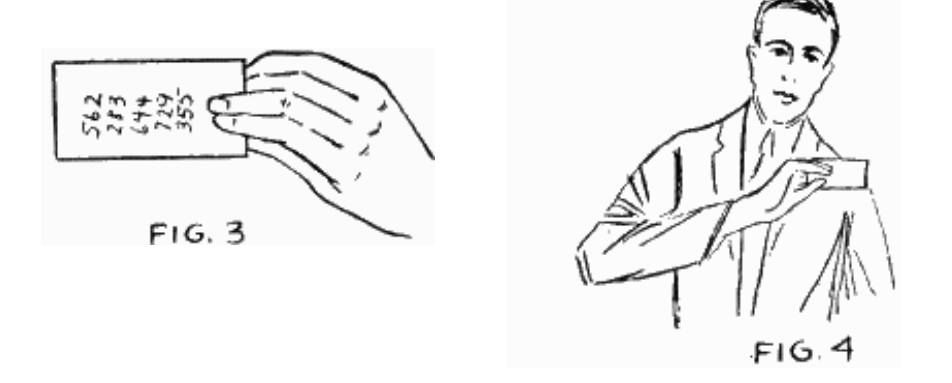
Hold card in front of you a little below level of chin and in front of left shoulder, as in Figure 4.
Swing right hand toward the right. As you do this, the card is brought to a sharp angle in the vision of the audience, but it is not turned enough to expose the numbers on the back. Move illustrated in Figure 5, next page.
When arm is about halfway down in the movement, force card downward with right thumb. Do this quickly. See Figure 6, next page.
Continue movement until hand is thrust out at side as in illustration 7. The long movement from left shoulder across body and out to side and then the quick movement of turning card downward suddenly with thumb serves to give the illusion of turning card over and showing it on both sides.
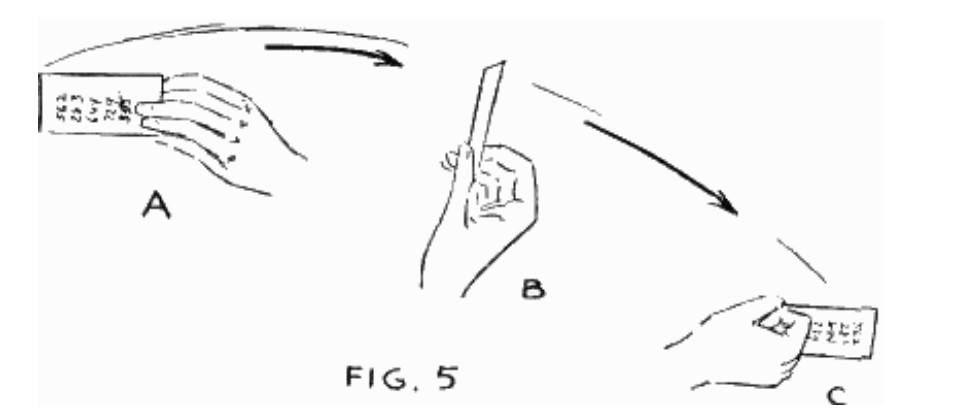
The whole movement should be done quickly and smoothly without hesitation -- just as you would do if
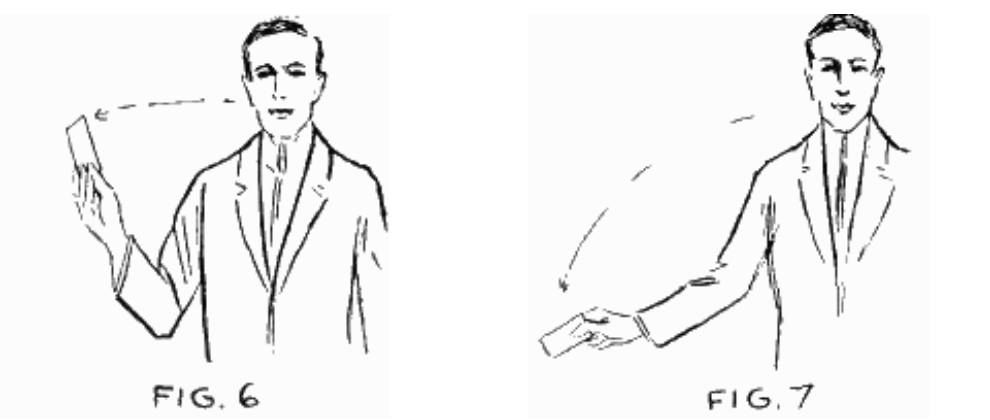
you really showed both sides of card.
"We should have a portable writing desk. This book will answer the purpose." Pick up book and place card on it, blank side up, as illustrated in Figure 8.
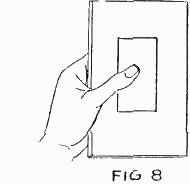
Reach into pocket and take out pencil.
"I would like to have someone write any number of three digits on this card. A number like 343, 864, and so on -- any number that you choose. Write it so that several more may be placed beneath it and so that the total may be secured."
Give book and card to a spectator. When he or she has written first number, give book and card to another member of the audience and have him write another number under the first.
"And you, sir, will you write a number of three digits right beneath this one."
Continue until five people have written numbers.
WARNING: Have people who write these numbers on one side of
room and not too close to each other.
Now move to other side of room, carrying book and card. You must be in a position where there is no one behind you. Hold book up for a moment so that card is not visible to audience. Book is held in both hands. The left hand holds book firmly. The third, fourth, and fifth fingers of right hand are under book; the finger and thumb hold the card.
Under cover of book, turn card over quickly with forefinger and thumb of right hand. Movement is toward left, as in Figure 9. This brings prepared side of card to top.

Hold card in place with thumb of left hand and remove right hand from book and card entirely. Take pencil and draw a line under the figures. Give card and book to someone on opposite side of room from where spectators are who wrote down the numbers. Ask this spectator to add the numbers and write down the sum.
"You look like a very good mathematician, sir. Would you mind just adding up the numbers and writing the sum beneath them?"
When this is done, take up book and card and hold in left hand. Put pencil in upper coat or vest pocket.
"The sum is two thousand, five hundred, and seventy-three. Two - five - seven - three. Is that correct, sir? Will you all remember the numbers -- two, five, seven, three? Now I am going to show you a very odd experiment in legerdemain. Let us first sum up the situation. The young lady here holds a blank piece of tissue paper. Several numbers have been written on this card. You each had your own free choice of numbers. I could not possibly have known what you were going to write. The gentleman has added up the numbers and the sum is 2573. What I intend to do is to cause the spirit of the numbers to travel and write themselves one at a time on the ball of tissue paper that the lady holds."
Place thumb and first and second fingers of right hand on card, apparently picking up the numbers and then throwing it in the direction of the ball of paper.
"Two!"
Repeat movement.
"Five! Pardon me, Madam, do you feel anything? Nothing? Perhaps you are not sensitive to spirits." Repeat throwing movement.
"Seven! Certainly you felt the number go that time." Repeat throwing movement.
"Three! Now, if you will please unroll the ball of paper . . ." Lady unrolls paper.
"Do we find that the spirits imprinted the numbers well on the paper?"
After lady has unrolled paper and looked at it take it from her and spread it out well. Hold it up so that all of audience can see the numbers.
"There, just as I said, the sum two - five - seven - three has been carried mysteriously to the paper. That is what they call the handwriting on the wall."
NOTE: You can change forged numbers by varying numbers you write on card. I seldom use the same numbers twice.
2. THE SPIRIT MATHEMATICIAN
This gives you another method of obtaining a definite sum from your audience, one which you have determined on beforehand.
EFFECT:
Performer shows a plain piece of white paper. Spectator is asked to examine it and then place it in an empty envelope and seal the envelope. Performer then asks various members of the audience to call out numbers. These he writes on a card. The card is given to a spectator, who is requested to add the numbers and call out the sum. The envelope is then opened and the numbers of the sum are found to be cut out of the piece of paper.
PARAPHERNALIA:
1--A piece of plain, white bond paper, 3 x 5 inches.
2--Another piece of bond paper the same size with the number 45 cut out of it. You can do this easily with a sharp penknife. See Figure 10. Save the numbers that have been cut out as well as the paper from which they have been cut.

3--A small card on which to write numbers.
4--A book to use as a support for writing.
5--A pencil.
6--A pen-knife or small dagger.
7--A special envelope.
We will designate this envelope throughout the course as the DOUBLE ENVELOPE.
This is a simple but clever piece of paraphernalia which can be used in many magical effects.
It is very easy to make.
With it you can materialize, vanish, or transform flat articles like cards, pieces of paper, etc.—that is, you can cause them to appear, to disappear, or to change form.
HOW TO MAKE:
Take two plain manila envelopes. These must be of good weight so that they are as nearly opaque as possible. Or you may use colored envelopes that are opaque.
Cut the front side with the flap from one of the envelopes, about one-sixteenth of an inch from the bottom and side edges. This leaves you a flat piece of paper with a flap as shown in illustration 11.
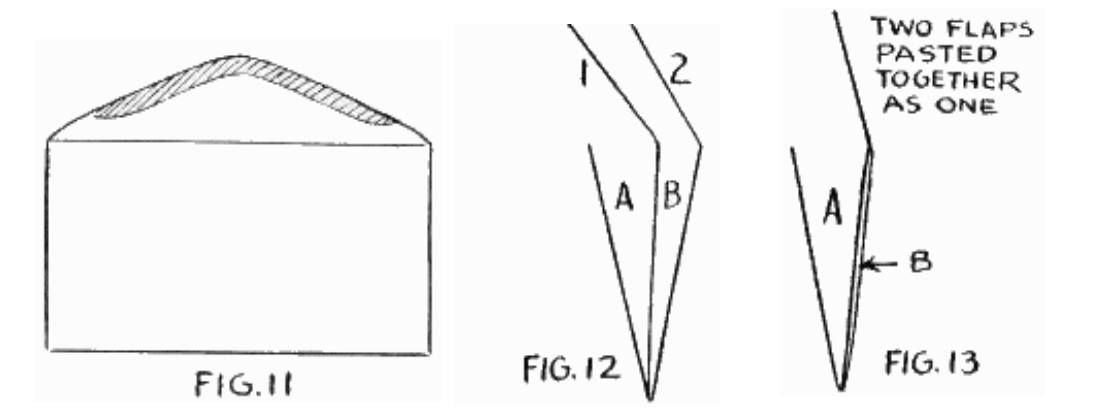
Insert this piece of paper and flap into the other envelope so that the gummed flaps both face the same way and fit well together. This insert acts as a wall.
We shall call the space in front of insert A and the space behind it B. See Fig. 12.
In space B place the piece of paper with the number 45 cut out of it and the cut-out numbers 4 and 5 also. Wet the gummed portion of flap 2 and paste it onto flap 1, as illustrated in Figure 13. Sometimes I glue down the whole flap, not just the edge.
Open up envelope. To all appearances it looks like an ordinary envelope with nothing in it. Audience will never suspect that it has a false partition and a prepared paper in it.
To Perform:
Have prepared envelope, piece of paper, book, card, pencil, and knife or dagger handy on nearby table.
Pick up piece of paper and envelope.
"There are some effects in magic that I do not know whether to believe or not, myself. They are just as puzzling to me as to my audiences. I do them and then wonder how I did them. Here is a trick that I have often wondered about. I have here an empty envelope and a piece of paper. Would you, sir, be kind enough to examine this piece of paper?"
Give paper to gentleman.
"Quite ordinary, is it not? And yet, I sometimes think quite extraordinary. I picked it up in a quaint old book store. Found several sheets of it in an old second-hand book I bought. One of these sheets had written across it these words, 'Someday a magician will use this paper. Prize it highly for you may never obtain any more of it.' Rather odd, don't you think? I wish I knew who put the paper in the book. In the back of this same book were several envelopes and this knife (or dagger). This is one of the envelopes. I could find nothing queer about them except that they were empty. I thought that maybe there might be money in them. Can you, sir, see any money?"
Show inside of envelope to spectator. Envelope looks empty, of course. "And will you please place this piece of paper inside of the envelope yourself?" Spectator places paper inside and you seal the envelope.
"Let us seal it inside, then run this knife (or small dagger) through the envelope. I will just set it here in full view."
Run blade of knife or dagger through front side of envelope as in Figure 14. Set envelope up against something on the table in full view of the audience, or give to someone to hold. Spectator should hold knife (or dagger) with envelope suspended on it.
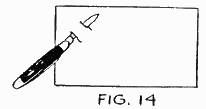
Pick up card and book and pencil from table.
"I do not need to tell you that this is a book, this is a card. . ." Show both sides of book and card.
"And this is a pencil. How good are you at mathematics? I suppose all of us can count to ten. That's all we have to do is to count to ten. We have nine numbers to select from. I want several of you to call out numbers and I will write them on this card. Call them slowly that I can write them down. All right, sir, start the ball rolling. Just call any number from one to nine."
Someone calls number—say, for instance, five. You write it down.
"All right, another number from someone else. You may call any number or repeat one that has already been called."
Put down the next number called—say, seven. See Figure 15.

IMPORTANT:
AFTER YOU HAVE WRITTEN DOWN THREE NUMBERS ON THE CARD, LEAVE A SPACE FOR A NUMBER TO BE WRITTEN IN LATER, as shown in Figure 16, next page.
Then proceed writing down the numbers called. But as you write the numbers, ADD THEM MENTALLY UNTIL YOU REACH A SUM BETWEEN 36 and 45.
If the sum should happen to be 36, you may call for another number. The most that this number could be is nine so that you run no risk of exceeding the sum you want—45. If you reach a sum greater than 36, however, call for no more numbers.
Let us presume that the numbers which have been called are those written in the top list. The sum so far is 42.
To get the sum of 45, which is on the prepared paper, add the number three in the space left in the list.
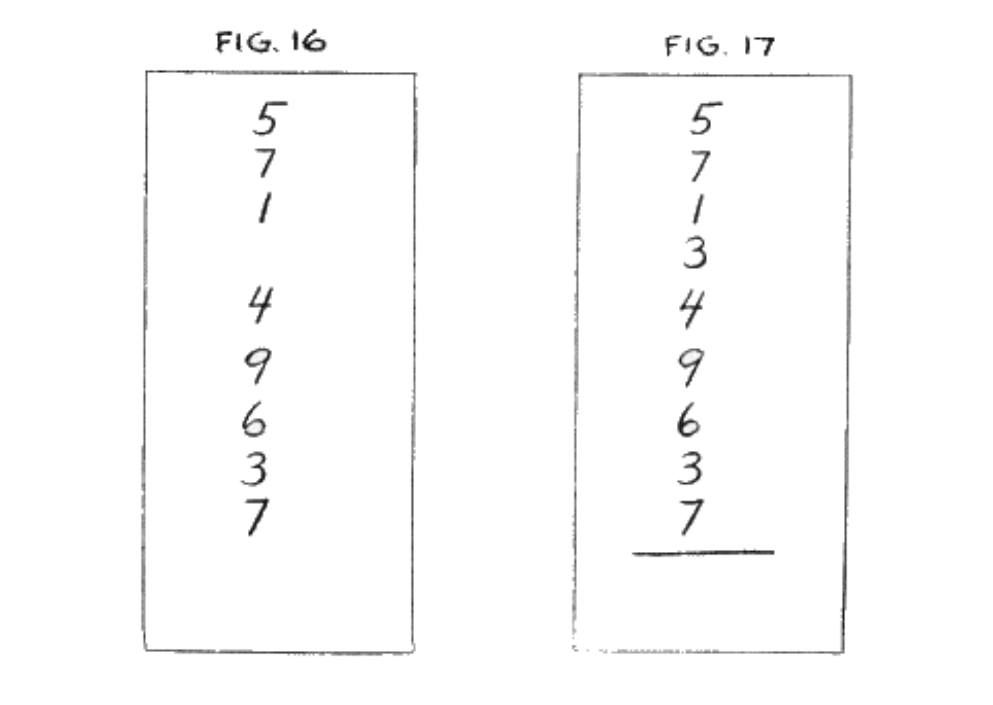
Then draw a line under the figures. See Figure 17.
"Now, let me read these numbers and each one may check up on his number. 5-7-1-3-4-9-6-3-7." These should be read rather quickly.
"Will you please add them up?"
Give card to someone to add numbers. When he has done that, ask for the answer.
"And what is the total? 45. Thank you. Now, remember this. Several of you called out numbers which you selected yourselves. We checked up on them and this gentleman (or lady) added these numbers and found the total to be 45. You said 45, did you not? Well, here is where the mystery starts." Pick up envelope.
"A few moments ago the gentleman there put a piece of paper in this envelope, and I inserted this phantom knife (or dagger)." Remove knife.
Holding envelope with flap side toward you, tear off the end and reach into Space B (nearest audience). As you do this, push middle partition firmly against side of envelope nearest you. Tip envelope over a little and take out the prepared paper and the cut-out figures. While doing this, you may walk up to a spectator if you are performing in a parlor or club.
"If you will note, sir, some strange influence has been at work on the paper and has cut out with the blade of a phantom knife (or dagger) the same sum that the gentleman found your numbers totaled—45." Hold up paper so that all can see it, then hold up the numbers 4 and 5.
"The envelope is empty, not even a trace of the spirit of the phantom knife (or dagger)—or even footprints."
Show inside of envelope, passing it around rather hurriedly and at a safe distance from audience. If inner partition is held tight against rear side of envelope, this is easy to do without detection.
"Will you, sir, please examine the paper and the numbers. Rather odd, isn't it? Maybe some day I will solve the secret and then be able to tell you how it is done."
NOTE:
With a little concentration, you should have no trouble in adding the numbers mentally. From time to time vary the number you want forced. You may use any number from 35 to 50.
Suppose you want to use 41 and have that cut out of the prepared piece of paper. Assume that various members of the audience give you the following numbers:
As 41 is the number to be FORCED, simply place the number 2 between 4 and 9 and you have raised your sum to 41.
Both methods of forcing a number, as described in the preceding two tricks, you will find very useful. They may be used interchangeably in both tricks. You may use the ball of tissue paper in this second trick and the cut paper in the first trick.
THE NUMBERS ON THE ARM
An interesting variation of these mathematical tricks is this: Write the number to be forced on the left forearm with a brush, soft stick, or pencil dipped in milk or lemon juice, or you may use a piece of soap. Let this dry well on the arm.
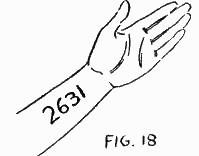
After numbers have been written on the card and the sum determined by a spectator, pick up a piece of paper or the same card and burn it in a dish. Rub the ashes over the forearm and the number will stand out in black on the arm, as in Fig. 18. The ashes will adhere to the milk, lemon juice, or soap.
3. RAPID BANKING
EFFECT:
Performer shows one envelope with the word Bank printed on it and a plain envelope, both empty. Performer borrows a dollar bill and tells owner to remember number on bill for identification. He then places this bill in the empty envelope marked Bank. Taking out his check book, he writes himself a check for $1, places it in the other envelope, and seals the envelope. Magician tells of the difficulty one encounters in trying to get checks cashed while traveling and says he is fortunate in always being able to get checks cashed instantly. He tears open the envelope marked Bank and there, instead of the dollar bill, is the check. He opens the other envelope and finds the dollar bill there. He returns it to the owner and asks him to identify it by number.
PARAPHERNALIA:
1--Two DOUBLE ENVELOPES, as described in last effect, preferably one of one color and one of another color.
2--A dollar bill, not too old or too new.
3--Check book.
4--Pen to write check.
5--A dollar bill borrowed from audience.
SECRET AND PATTER:
To Prepare:
On one of the envelopes letter the word BANK. See Fig. 19.
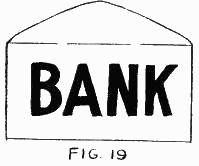
In Space B, between partition and front of envelope, place a check written out for one dollar.
In the plain envelope in Space B, place the dollar bill. Just before doing so commit to memory the last three numbers and letter on the bill—for instance, let us say that they are 735A.
Now seal the flaps 1 and 2 together on each envelope so that they will look like ordinary unprepared envelopes.
Have check book and pen in pocket.
To Perform:
Start with patter:
"Have you ever had any difficulty in getting checks cashed? Well, I have, especially among strangers. In order to overcome this difficulty, I sought out a way of cashing my own checks. I did this by establishing a rapid-fire connection with the bank. Perhaps you would like to know how I do this. First of all, I wish to borrow a dollar bill, not too old and not too new."
There are three kinds of dollar bills so try to get the nearest match to the kind of bill you have sealed in the double envelope. If a new bill is offered to you, say—
"I really hate to take such a nice new dollar bill away from a man on pay day."
If the bill offered is too old and frayed, say--
"This bill is pretty far gone. Haven't you one with more endurance. It is going to travel far and should be sturdy and a little younger."
The bill with the eagle is perhaps the most common type. If you do not get that kind, however, the others will look similar enough.
Take bill from spectator.
"A kind-hearted gentleman who thinks I look honest lends me a dollar bill without interest. Now, let's remember the number on the bill so that we can identify it later. Put these last three numbers and letter down— 7, 3, 5, A."
These are the numbers on the bill in the envelope, but the audience thinks that you are reading the numbers of the bill you hold in your hands.
Pick up envelope marked Bank.
"This envelope will represent the bank. In it I will put to my credit the sum of one dollar—the gentleman's dollar— and then close the doors of the bank."
Fold bill in half as you did the one in the other envelope. Show envelope empty and then you put the bill into envelope or have a spectator do it. Seal envelope and place it upright in full view of every one or give it to a spectator to hold.
"Next, I will write myself a nice check."
Take check book from pocket, open it, and take pen from pocket.
"A nice check for the sum of one dollar, which I have in the bank. I could make it out for two dollars—but I am afraid the bank wouldn't appreciate it."
Write check to yourself for one dollar, making it out exactly the way you did the check you have sealed in secret compartment of BANK envelope.
"Let us place the check in this other envelope."
Show envelope empty, fold check and place inside. Seal envelope and place, upright on table or give to someone to hold in plain view.
"Now, for the secret system of banking. I need money. Do I walk up to some strange hotel clerk and ask him for it? Not much. I might not get it. So I just say, 'Tar-ix-a-cum, Tar-ix-a-co. Oh, where, oh, where, does my money go?' Then my money flies out of the bank and comes to me."
Pick up BANK envelope, tear it open so that the middle partition rests on back side of envelope, reach in and take out check. Hold envelope with opening toward audience and open end down. After check is out, give audience a hurried look into envelope.
"See, my check has already arrived in the bank and the dollar has flown." Give check to spectator or drop on table after showing it freely.
"Taking the other envelope in which I originally placed the check. . ."
Take other envelope, tear it open, and take out dollar bill. Show inside of envelope hurriedly. Be careful with this envelope, too, to have inner partition well up against the back side of envelope.
"We find the dollar bill which I deposited in the bank. We can easily check up this bill by the number." Look at number and show it to audience.
"The last three numbers—7, 3, 5, A. Was that not correct, sir? Thanks for the bill."
Return bill to owner. He thinks he is getting his original bill back, but he is really getting yours. Dispose of envelopes so that audience will not get a chance to inspect them too closely. In laying down envelopes, be sure to put them down with opening away from audience so there will be no chance of their seeing the secret partition in them.
ANOTHER RUSE which I occasionally use is to mark the check in the envelope Number 7. Then in writing the other check before the audience I ask someone to call out any number between 5 and 10. Through the working of a psychological law, the number called by the spectator most often will be 7. If seven is called, say, 'I will number this check 7. Remember you had your choice of numbers. It will help you to identify the check.'
Then when you take duplicate check from envelope, call particular attention to the identification number.
If someone calls out a number other than 7, say 8 -- you may just say, "Eight—ah a magic number. I shall place this check in the keeping of eight spirits", and pay no more attention to the number.
For my professional brethren, let me say that I often have check in BANK envelope stamped with PAID mark that banks use when check is cashed; and then I prove that it is the same check I started with by the "Torn corner identification." For the beginner, let me say that I shall explain torn corner work later on in the course.
You are not quite ready for it at this stage.
TARBELL SYSTEM, INCORPORATED, Chicago.
Lesson 9
In this lesson I initiate you into some excellent card tricks. I know you are tremendously interested in card effects. These I give you now are only the beginning of a list of many amazing card experiments which I have planned for you.
1 - A card is drawn from the deck by a spectator, replaced, deck is shuffled and put into the cardboard box. Flap of box is closed. Performer has spectator tie case onto left hand with a handkerchief. On command the chosen card rises from ease and drops to floor.
2 - A sealed card mystery. Deck is given to spectator to shuffle. Spectator then removes three cards from pack and places them in three envelopes. These envelopes are sealed into larger envelopes. Rest of pack is cut into two parts. Spectator chooses one envelope. Card is removed. Spectator then removes top cards of two sections of cut pack of cards and finds that one bears the suit of the chosen card and the other bears the number.
3 - The Psychologist's Dream. Deck is divided into two portions. One part is spread out and spectator thinks of a card in this part. Part is squared and laid on table. Performer has spectator draw card from other section of deck and place it in performer's pocket without looking at it. Then spectator is asked to look through part of deck from which he mentally selected a card and finds that that card is gone. Performer takes the card out of his pocket and it proves to be the card that spectator thought of.
Bạn đang đọc truyện trên: truyentop.pro